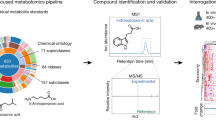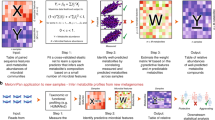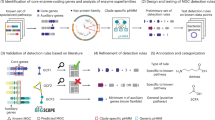Abstract
The environmental metabolome and metabolic potential of microorganisms are dominant and essential factors shaping microbial community composition. Recent advances in genome annotation and systems biology now allow us to semiautomatically reconstruct genome-scale metabolic models (GSMMs) of microorganisms based on their genome sequence1. Next, growth of these models in a defined metabolic environment can be predicted in silico, mechanistically linking the metabolic fluxes of individual microbial populations to the community dynamics. A major advantage of GSMMs is that no training data is needed, besides information about the metabolic capacity of individual genes (genome annotation) and knowledge of the available environmental metabolites that allow the microorganism to grow. However, the composition of the environment is often not fully determined and remains difficult to measure2. We hypothesized that the relative abundance of different bacterial species, as measured by metagenomics, can be combined with GSMMs of individual bacteria to reveal the metabolic status of a given biome. Using a newly developed algorithm involving over 1,500 GSMMs of human-associated bacteria, we inferred distinct metabolomes for four human body sites that are consistent with experimental data. Together, we link the metagenome to the metabolome in a mechanistic framework towards predictive microbiome modelling.
This is a preview of subscription content, access via your institution
Access options
Access Nature and 54 other Nature Portfolio journals
Get Nature+, our best-value online-access subscription
$29.99 / 30 days
cancel any time
Subscribe to this journal
Receive 12 digital issues and online access to articles
$119.00 per year
only $9.92 per issue
Buy this article
- Purchase on Springer Link
- Instant access to full article PDF
Prices may be subject to local taxes which are calculated during checkout




Similar content being viewed by others
References
Henry, C. S. et al. High-throughput generation, optimization and analysis of genome-scale metabolic models. Nat. Biotechnol. 28, 977–982 (2010).
Marcobal, A. et al. A metabolomic view of how the human gut microbiota impacts the host metabolome using humanized and gnotobiotic mice. ISME J. 7, 1933–1943 (2013).
Martiny, J. B. H., Jones, S. E., Lennon, J. T. & Martiny, A. C. Microbiomes in light of traits: A phylogenetic perspective. Science 350, aac9323 (2015).
Tjalsma, H., Boleij, A., Marchesi, J. R. & Dutilh, B. E. A bacterial driver-passenger model for colorectal cancer: beyond the usual suspects. Nat. Rev. Microbiol. 10, 575–582 (2012).
Zeller, G. et al. Potential of fecal microbiota for early-stage detection of colorectal cancer. Mol. Syst. Biol. 10, 766 (2014).
Smith, M. B. Natural bacterial communities serve as quantitative geochemical biosensors. mBio 6, e00326-15 (2015).
Merrifield, C. A. et al. Neonatal environment exerts a sustained influence on the development of the intestinal microbiota and metabolic phenotype. ISME J. 10, 145–157 (2016).
Adams, R. I., Bateman, A. C., Bik, H. M. & Meadow, J. F. Microbiota of the indoor environment: a meta-analysis. Microbiome 3, 49 (2015).
Garza, D. R. & Dutilh, B. E. From cultured to uncultured genome sequences: metagenomics and modeling microbial ecosystems. Cell. Mol. Life Sci. 72, 4287–4308 (2015).
Larsen, P. E. et al. Predicted Relative Metabolomic Turnover aPRMTa: determining metabolic turnover from a coastal marine metagenomic dataset. Microb. Inform. Exp. 1, 4 (2011).
Levy, R. & Borenstein, E. Metabolic modeling of species interaction in the human microbiome elucidates community-level assembly rules. Proc. Natl Acad. Sci. USA 110, 12804–12809 (2013).
Hanson, N. W. et al. Metabolic pathways for the whole community. BMC Genom. 15, 619 (2014).
Silva, G. G. Z., Green, K. T., Dutilh, B. E. & Edwards, R. A. SUPER-FOCUS: a tool for agile functional analysis of shotgun metagenomic data. Bioinformatics 32, 354–361 (2016).
Orth, J. D., Thiele, I. & Palsson, B. Ø. What is flux balance analysis? Nat. Biotechnol. 28, 245–248 (2010).
Human Microbiome Project Consortium. Structure, function and diversity of the healthy human microbiome. Nature 486, 207–214 (2012).
Martin, J. et al. Optimizing read mapping to reference genomes to determine composition and species prevalence in microbial communities. PLoS ONE 7, e36427 (2012).
Kortman, G. A. M. et al. Microbial metabolism shifts towards an adverse profile with supplementary iron in the TIM-2 in vitro model of the human colon. Microb. Physiol. Metab. 6, 1481 (2015).
Vitali, B. Vaginal microbiome and metabolome highlight specific signatures of bacterial vaginosis. Eur. J. Clin. Microbiol. 34, 2367–2376 (2015).
Wishart, D. S. et al. HMDB 3.0—The Human Metabolome Database in 2013. Nucleic Acids Res. 41, D801–D807 (2013).
Gao, X., Pujos-Guillot, E. & Sébédio, J.-L. Development of a quantitative metabolomic approach to study clinical human fecal water metabolome based on trimethylsilylation derivatization and GC/MS analysis. Anal. Chem. 82, 6447–6456 (2010).
Tsuruoka, M. et al. Capillary electrophoresis-mass spectrometry-based metabolome analysis of serum and saliva from neurodegenerative dementia patients. Electrophoresis 34, 2865–2872 (2013).
Sugimoto, M. et al. Physiological and environmental parameters associated with mass spectrometry-based salivary metabolomic profiles. Metabolomics 9, 454–463 (2013).
Dame, Z. T. et al. The human saliva metabolome. Metabolomics 11, 1864–1883 (2015).
Bouslimani, A. et al. Molecular cartography of the human skin surface in 3D. Proc. Natl Acad. Sci. USA 112, 2120–2129 (2015).
Larsen, P. E. & Dai, Y. Metabolome of human gut microbiome is predictive of host dysbiosis. GigaScience 4, 42 (2015).
Magnúsdóttir, S. et al. Generation of genome-scale metabolic reconstructions for 773 members of the human gut microbiota. Nat. Biotechnol. 35, 81–89 (2017).
Reed, J. L. in The Chemistry of Microbiomes (National Academies of Sciences, Engineering and Medicine) Chap. 12 (National Academies Press, Washington, DC, 2017); https://doi.org/10.17226/24751.
Rodriguez-Valera, F. et al. Explaining microbial population genomics through phage predation. Nat. Rev. Microbiol. 7, 828–836 (2009).
Zhernakova, A. et al. Population-based metagenomics analysis reveals markers for gut microbiome composition and diversity. Science 352, 565–569 (2016).
Wishart, D. S. Advances in metabolite identification. Bioanalysis 3, 1769–1782 (2011).
Li, H. & Durbin, R. Fast and accurate short read alignment with Burrows–Wheeler transform. Bioinformatics 25, 1754–1760 (2009).
Pluskal, T., Castillo, S., Villar-Briones, A. & Orešič, M. MZmine 2: modular framework for processing, visualizing, and analyzing mass spectrometry-based molecular profile data. BMC Bioinform. 11, 395 (2010).
Zhou, J. & Yin, Y. Strategies for large-scale targeted metabolomics quantification by liquid chromatography-mass spectrometry. Analyst 141, 6362–6373 (2016).
Ebrahim, A., Lerman, J. A., Palsson, B. O. & Hyduke, D. R. COBRApy: COnstraints-Based Reconstruction and Analysis for Python. BMC Syst. Biol. 7, 74 (2013).
Hastings, W. K. Monte Carlo sampling methods using Markov chains and their applications. Biometrika 57, 97–109 (1970).
Barbu, V. S. & Limnios, N. Semi-Markov Chains and Hidden Semi-Markov Models toward Applications 1st edn, Vol 191 (Springer-Verlag, New York, 2008).
Acknowledgements
We thank M. Kooyman (SURFsara) for help implementing MAMBO on the Netherlands Life Science Grid, C.R. Berkers (Utrecht University) for insights regarding the annotation of untargeted metabolome datasets and the CMBI Comics Group for fruitful discussions. D.R.G. is supported by the Science Without Borders program of CNPQ/BRASIL. B.E.D. is supported by Netherlands Organization for Scientific Research (NWO) Vidi grant 864.14.004.
Author information
Authors and Affiliations
Contributions
D.R.G. created the algorithm and performed the experiments. All authors devised the study and wrote the manuscript.
Corresponding author
Ethics declarations
Competing interests
The authors declare no competing interests.
Additional information
Publisher’s note: Springer Nature remains neutral with regard to jurisdictional claims in published maps and institutional affiliations.
Supplementary information
Supplementary Information
Supplementary Figures 1–3, Supplementary Table 1, Supplementary References and Supplementary Table 2–3 legends.
Supplementary Table 2
Metabolomic profiles predicted by MAMBO and genes-only approach based on 37 oral, 50 skin, 39 stool and 49 vaginal metagenomes, and 6 experimentally measured metabolomic profiles. Values are normalised predicted abundances.
Supplementary Table 3
Pearson correlations between 6 measured metabolomic profiles and 175 predicted metabolomic profiles by MAMBO and genes-only approach. Correlations are only shown if >5 metabolites of the predicted metabolites were measured and vice versa.
Rights and permissions
About this article
Cite this article
Garza, D.R., van Verk, M.C., Huynen, M.A. et al. Towards predicting the environmental metabolome from metagenomics with a mechanistic model. Nat Microbiol 3, 456–460 (2018). https://doi.org/10.1038/s41564-018-0124-8
Received:
Accepted:
Published:
Issue Date:
DOI: https://doi.org/10.1038/s41564-018-0124-8
This article is cited by
-
Genome-scale metabolic modeling of Aspergillus fumigatus strains reveals growth dependencies on the lung microbiome
Nature Communications (2023)
-
Predicting metabolomic profiles from microbial composition through neural ordinary differential equations
Nature Machine Intelligence (2023)
-
Candida expansion in the gut of lung cancer patients associates with an ecological signature that supports growth under dysbiotic conditions
Nature Communications (2023)
-
The human microbial exposome: expanding the Exposome-Explorer database with gut microbial metabolites
Scientific Reports (2023)
-
A social niche breadth score reveals niche range strategies of generalists and specialists
Nature Ecology & Evolution (2023)



